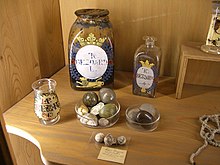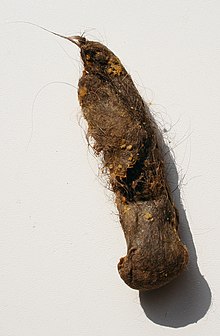Bezoar

A bezoar (of persian Padzahr , "antidote"), even Bezoarstein and stomach stone called, is a clumping of swallowing indigestible materials such as hair , of the as trichobezoar physiologically in the stomach of birds of prey or cats after the entangling prey is formed. The indigestible fur / hair remains are choked up and thrown out after a while. In birds of prey, the food remains that are excreted in this way are known as bulges .
Hair bezoars are also found in the stomach or rumen of cattle and other ruminants, but also, for example, in the stomach of rabbits and antelopes. Apparently the hair collects here, which is picked up by licking the fur.
Bezoars in humans
In rare cases - e.g. B. in trichotillomania - the repeated swallowing of hair is observed in humans and is then referred to as trichophagia . Rarely are human bezoars, as described in the 18th century by Georges Louis Leclerc and examined more closely in the 19th century by Charles Robin , not only in the stomach, but also in the small or large intestine and can lead to an intestinal obstruction ( Ileus). Bezoars in the pancreas , which are made up of a gum-like mass, have also been reported.
In addition, bezoars can also form in infants from thickened, curdled milk (milk plug syndrome ) - in this case it is a lactobezoar . A phytobezoar consists of insufficiently chewed vegetable fibers. A drug bezoar can develop as part of antacid therapy .
Bezoar stones

If the bezoar ball is covered by a hard crust due to its long stay in this environment, it is called a bezoar stone . In veterinary medicine , bezoar stones are called pathological gastroliths .
Bezoar stones are particularly common in the digestive organs of ruminants , as the food in them is repeatedly turned around. Hair or plant fibers can become matted and form bezoars. If these are deposited in small pockets in the intestinal wall (the so-called diverticula ), a hard crust can form on the bezoars after a while.
Folk medicine and magic
In ancient times, many cultures ascribed magical powers to bezoars. Sushruta , an Indian doctor and author of an important Ayurvedic work, is considered to be the first to describe medical effects . Bezoars were also used to magically influence the weather.
In traditional Chinese medicine , bezoars are still said to have medicinal properties and these are traded at high prices. A 140 gram stomach stone from a domestic pig discovered in November 2017 was estimated to be worth 3 million yuan (approx. 400,000 euros ).
Bezoars should above all protect against poisoning , for example with potentially poisoned drinks. Bezoar stones were sometimes made into precious pieces of jewelry that could be dipped into the drinking vessel on a chain. A few copies are on display in the treasury of the Munich Residence and also in the Kunstkammer Vienna .
Bezoars also appear in popular literature as remedies and magic substances, for example in Volume 1 and Volume 6 of Harry Potter or in Neil Gaiman's Sandman .
See also
literature
- Wolfgang Wegner: Bezoar stone. In: Werner E. Gerabek , Bernhard D. Haage, Gundolf Keil , Wolfgang Wegner (eds.): Enzyklopädie Medizingeschichte. De Gruyter, Berlin / New York 2005, ISBN 3-11-015714-4 , p. 173.
Individual evidence
- ↑ Bezoar at Duden online
- ^ Klaus Bergdolt : Medical in the Mainfränkisches Museum zu Würzburg. In: Würzburger medical history reports 8, 1990, pp. 41–52; here: p. 50 f. (Bezoar of Countess Sofia von Schönborn)
- ↑ Wang Xuemei: Farmer finds a stone worth 3 million yuan in the pork belly. In: China.org.cn. November 30, 2017. Retrieved December 11, 2017 .
- ↑ For example, Volume 1: Harry Potter and the Philosopher's Stone , p. 152.
Web links
- Hairballs: Myths and Realities behind some Medical Curiosities. National Museum of Health and Medicine , USA (English)
- Phytobezoar: an unusual cause of intestinal obstruction. Report about a phytobezoar in a human ( doi : 10.2349 / biij.1.1.e4 , English)
